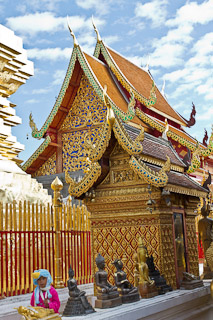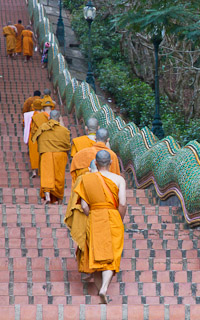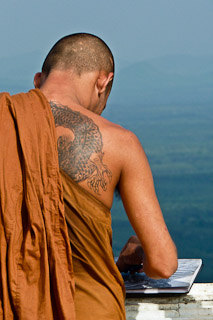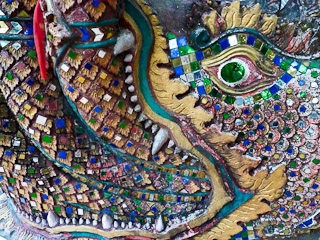 It was difficult to think back on our journey to Thailand this past December without vividly recalling the myriad of temples that dotted the countryside. These beautiful structures were an integral part of the landscape and culture of Thailand which for us stood out as the physical representation of our departure from the ‘Western’ world.
It was difficult to think back on our journey to Thailand this past December without vividly recalling the myriad of temples that dotted the countryside. These beautiful structures were an integral part of the landscape and culture of Thailand which for us stood out as the physical representation of our departure from the ‘Western’ world.
The first stop on our journey was the city of Chiang Mai. We were fortunate to stay in a guesthouse which was located directly across the street from one of the larger temples within the Old City district. It was a surreal experience to sit on the patio each morning with a steaming cup of coffee and watch as the monks, barefoot and draped in their brightly colored orange robes, left the complex to collect food for the day.
In a country in which nearly 95% of the population are Buddhist, the significance of these temples, or ‘wats’, to daily life can’t be understated. For perspective, within the 1.6 square kilometer area of the Old City were located over 30 active temples. The temples themselves were far more than just a single building, but were composed of a complex of buildings where the monks lived, studied and practiced their religion.
The buildings themselves were stunning and often ornately decorated with multi-tiered roofs, brightly colored tiles, gold filigree and elaborate carvings. Though not a unifying feature of all Thai temples, we found that many were preceded by long staircases guarded by dragon-like creatures called naga, whose bodies guided the visitor up to the wat.
 In Chiang Mai, the most celebrated example of this architecture was the Wat Doi Sutep. Guarded by impressive naga, visitors climbed 309 steps to reach this temple complex. On the day we visited, we arrived in time to observe an alms procession of monks which had stopped to receive food offered by a local vendor. After giving their blessings, they then proceeded to climb the staircase single file back to their living quarters. Observing the monks themselves was an experience which never felt ordinary and photographing them in their daily life became a bit of an obsession.
In Chiang Mai, the most celebrated example of this architecture was the Wat Doi Sutep. Guarded by impressive naga, visitors climbed 309 steps to reach this temple complex. On the day we visited, we arrived in time to observe an alms procession of monks which had stopped to receive food offered by a local vendor. After giving their blessings, they then proceeded to climb the staircase single file back to their living quarters. Observing the monks themselves was an experience which never felt ordinary and photographing them in their daily life became a bit of an obsession.
By far, my favorite temple was the Wat Tham Sua, colloquially known as the ‘Tiger Cave Temple’. This temple was located in the southern district of Krabi where we had traveled towards the end of our trip. Though a popular tourist destination, there were no crowds waiting to share this experience.
 Perched atop a small mountain, the staircase to reach this temple literally clung to a sheer cliff as it wound its way up to the peak. For the monks who attend to this wat, the repetitive action of climbing the staircase was said to act as a kind of meditation. For us, climbing the 1,237 steps was less a religious experience than a physical feat of endurance, but it did come with a different sort of reward. The view over the surrounding mountains was beautiful and very unlike anything we had seen in the States. It was here I photographed a single monk quietly sketching in his notebook from the temple balcony. Until our next visit, this is the image that will forever come to mind when remembering what Thailand was to me.
Perched atop a small mountain, the staircase to reach this temple literally clung to a sheer cliff as it wound its way up to the peak. For the monks who attend to this wat, the repetitive action of climbing the staircase was said to act as a kind of meditation. For us, climbing the 1,237 steps was less a religious experience than a physical feat of endurance, but it did come with a different sort of reward. The view over the surrounding mountains was beautiful and very unlike anything we had seen in the States. It was here I photographed a single monk quietly sketching in his notebook from the temple balcony. Until our next visit, this is the image that will forever come to mind when remembering what Thailand was to me.

